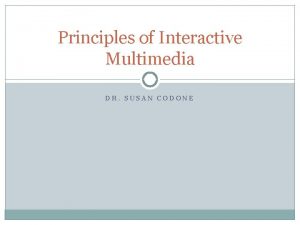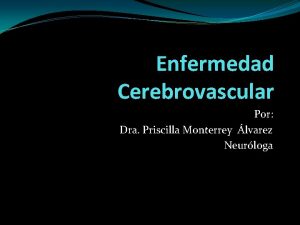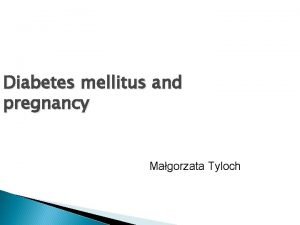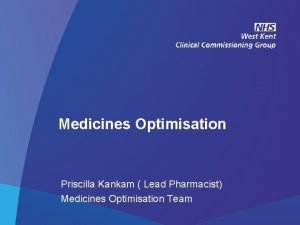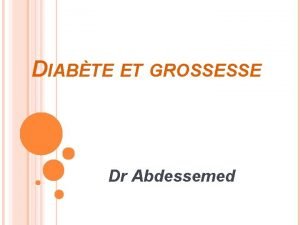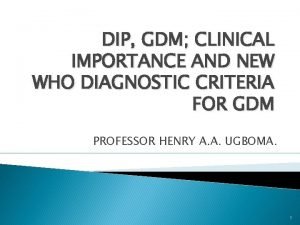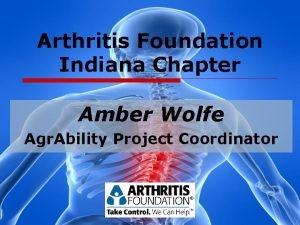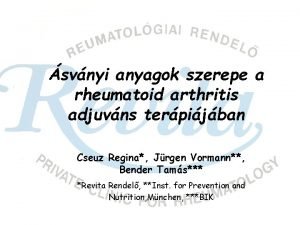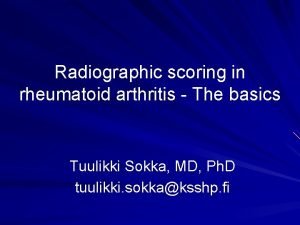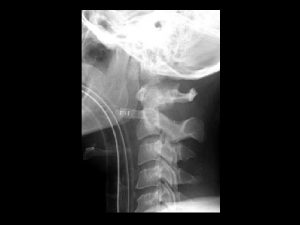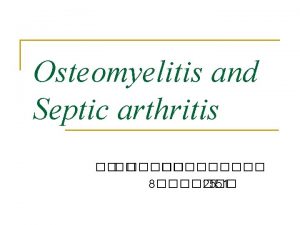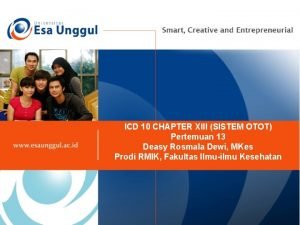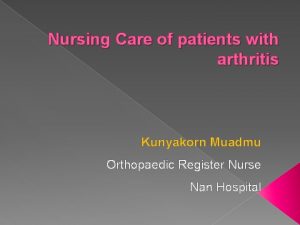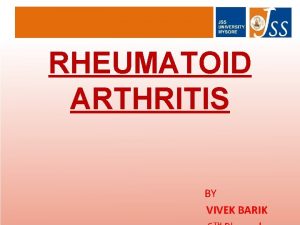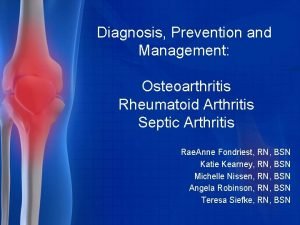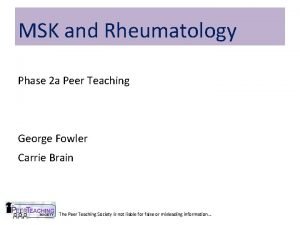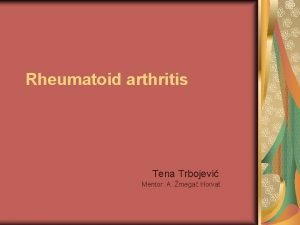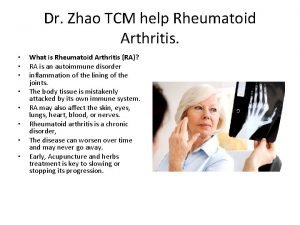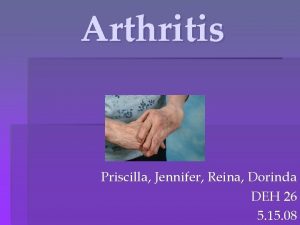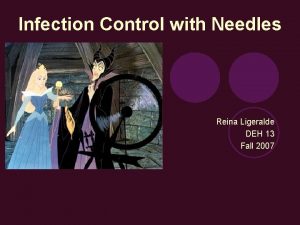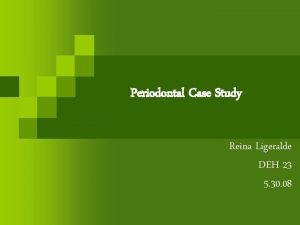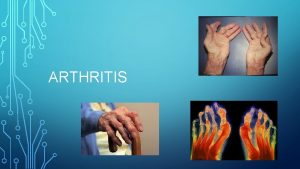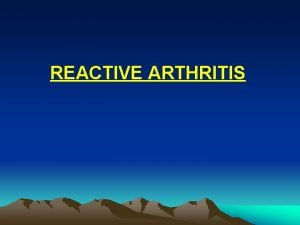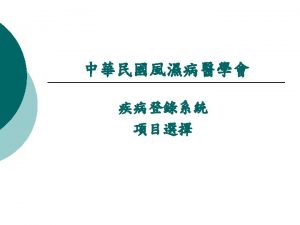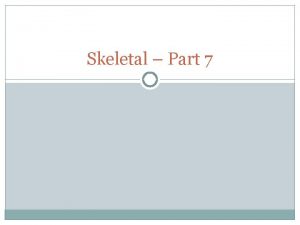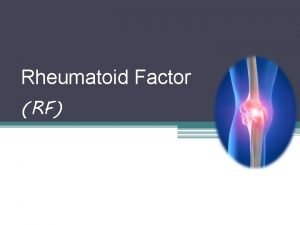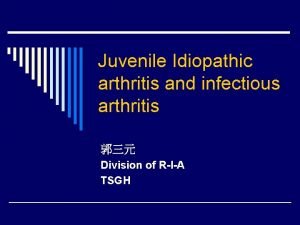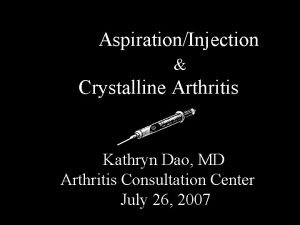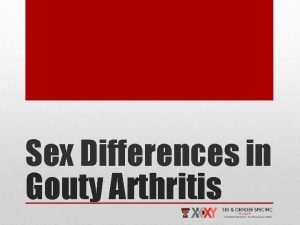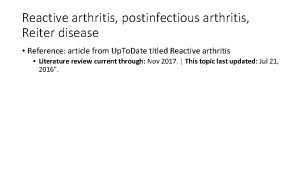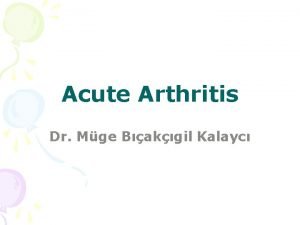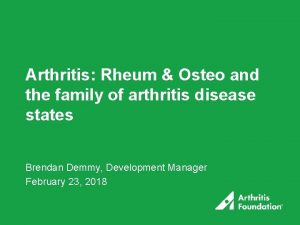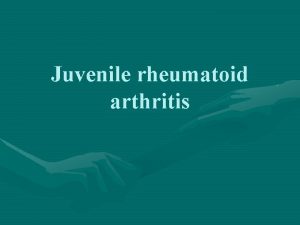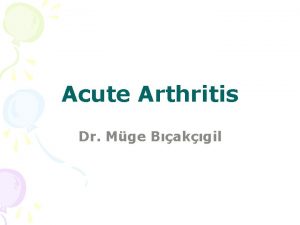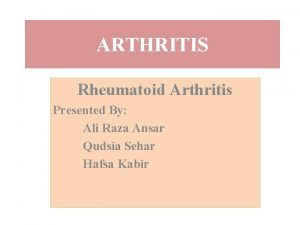Arthritis Priscilla Garcia Jennifer Klocki Reina Ligeralde Dorinda















































- Slides: 47

Arthritis Priscilla Garcia, Jennifer Klocki, Reina Ligeralde, Dorinda Thomas DEH 26 5. 15. 08

Patient Profile § § § Name – Rume Aritis Gender – Female Age – 45 Occupation – Stenographer Marital Status – Married Ethnicity – Caucasian

Medical History § Chief complaint – TMJ soarness, dry mouth, and teeth sensitivity § Dental History – § Patient has difficulty opening the jaw § 4/07 - last dental exam, BWX, and FM scale § 4/05 - last FMX § Medical History – § § Patient presents with recurrent finger ache and pain Rheumatoid arthritis since 1999

More Medical History § Medications – § Gold sodium thiomalate – helps slow down the disease process and decrease inflammation § Dental implications: stomatitis, gingivitis and glossitis § Aspirin – helps reduce pain § Dental implications: increased bleeding § Prednisone – used for inflammation § Dental implications: none noted § Vitals – BP: 125/74, P: 78, R: 17 § ASA III

Definition § An autoimmune disease of unknown origin that is characterized by symmetric inflammation of the joints, especially of the hands, feet, and knees

Incidence and Prevalence § Estimates of prevalence range 1 -2% of the population. § Disease onset usually occurs from ages 35 -50 years. § Severity of the disease varies widely from patient to patient and from time to time within the same patient. May is National Arthritis Month.

More Incidence and Prevalence § 3: 1 women to men ratio implies involvement of sex hormones in the susceptibility and sensitivity of the disease § Suggested factors in playing predisposing roles: § § § Psychosocial stress Education Socioeconomic status

Etiology § Unknown cause § Evidence seems to implicate an interrelationship of infectious agents, genetics, and autoimmunity. § Currently, circumstantial evidence suggests that food may play a role in the origin and treatment.

Pathophysiology 1. Edema of the 3. Granulation tissue covers synovium the articular surfaces and thickening and folding destroys the cartilage and to excessive, subchondral bone through proliferative, invasive enzymatic activity extending granulation tissue = to capsule and ligaments pannus distension and rupture 2. Marked infiltration of lymphocytes and plasma cells into the capsule 4. New bone or fibrous tissue is deposited fusion or loss of mobility


Complications § The life expectancy of persons with severe RA is shortened by 10 -15 years. § This increased mortality rate usually is attributed to § § § Pulmonary and renal disease Infection Gastrointestinal bleeding

Accompanying Complications §Skin ulcers §Muscle atrophy §Pericarditis §TMJ involvement §Anemia §Pulmonary interstitial fibrosis §Neutropenia §Keratoconjunctivitis sicca (Sjögren’s syndrome) §Digital gangrene §Amyloidosis §Thrombocytopenia §Splenomegaly (Felty’s syndrome)

Signs and Symptoms § The usual onset of rheumatoid arthritis is gradual and subtle. § A patient will first experience fatigue and weakness with joint muscle aches. § Then there is painful joint swelling of the hands and feet, spreading to several joints, and then progress to other joints symmetrically. § Joint involvement gradually progresses to immobility, contractures, subluxation, deviation, and other deformities.

Joints Most Commonly Affected §Fingers §Wrists §Ankles §TMJ (often involved in up to 75% of patients) §Knees §Elbows §Feet

Medical Management

Medical Management § Early diagnosis and treatment for rheumatoid arthritis is vital. § It can noticeably decrease the disability and pain and very likely lengthen the life span. § Treatment approach is palliative (alleviating illness) because there is no cure that exists for this disease.

Medical Management § Treatment Goals: § Reduce joint inflammation and swelling § Relieve pain and stiffness § Help and promote normal function § Goals are accomplished by: § § § Patient education Rest Exercise Physical therapy NSAIDs

Medical Management § Drugs for the management of RA have been divided into two groups: § 1. Control joint pain and swelling. (i. e. NSAIDs) § 2. Limit joint damage and improve longterm outcome. (i. e. DMARDs – diseasemodifying antirheumatic dugs)

NSAIDs = Drugs That Control Joint Pain and Swelling § Effective for pain, swelling, and stiffness § Most effective and safest for patients § Start patient on three-grain tablets 4 X a day, then adjust according to patient’s response § Too much aspirin can result in aspirin toxicity. § Common sign = tinnitus (ringing, buzzing, or hissing heard in the ear) § If this occurs, decrease the dosage. § May result in prolonged bleeding

Gold Compounds § Helpful in decreasing inflammation and slowing down the progress of the disease § Gold compound therapy must be carefully supervised. § Incidence of side effects is high. This includes: § Buccal ulcerations § Eczematous rashes § Neutropenia § Thrombocytopenia

Other Drugs § Antimalarial Drugs § Corticosteroids § Chloroquine or hydroxychloroquine § These drugs are used in combination with aspirin or corticosteroids. § Side effects include eye damage and blue-black intraoral pigmentation. § Prednisone or prednisolone § Most effective for reducing inflammation § Manages acute symptoms § Significant adverse effect is adrenal suppression; therefore, long-term usage is avoided.

Immunosuppressive Therapy § Effective in treating severe RA § Slows down the progression of the disease and decreases the damage to bones adjacent to joints § Drugs include methotrexate, azathioprine, cyclosporine, and tumor necrosis factor (TNF) inhibitors § Side effects include liver disease, lung inflammation, oral ulcerations, and increased susceptibility to infection

Combination Therapy § For patients with moderate to severe disease § Methotrexate used in combination with other agents § Most popular regimen is methotrexate, hydroxychloroquine, and sulfasalazine. § More effective than single-drug regimens § Does not appear to be hazardous and should be considered as initial treatment in patients with early, active RA

Surgery § Used to relieve severe pain and improve function of severely deformed joints that do not respond to medication and physical therapy § Variety of surgical procedures include: § § Arthroscopy Synovectomy Arthroplasty Total joint replacement

Dental Management

Considerations Prior to Dental Treatment § Patient comfort § Drug considerations § Joint prosthesis § TMJ involvement § Oral hygiene capability

Patient Comfort § Appointments should be kept short. § Encourage patient to change seating positions frequently. § Be creative, and use pillows or rolled towels to support deformed or crippled limbs.

Drug Considerations § Patient may be taking : § Aspirin § NSAIDS § Corticosteroids § DMARDs § Immunosuppressive agents

Aspirin Drug Considerations § Aspirin with NSAIDs § § § Analgesic Can cause prolonged bleeding Usually not clinically significant (does not put disease in remission) § Aspirin with corticosteriods § High risk for prolonged bleeding § Need to determine bleeding time § Most accurate test is the PFA-100 (platelet function analyzer) § Bleeding time should be under 20 minutes.

Other Drug Considerations § DMARDs § e. g. gold compound, penicillamine, sulfasalazine § Cause suppression of the bone marrow anemia, agranulocytosis, and thrombocytopenia § Need recent lab tests such as RBC count, WBC count, and bleeding time § Corticosteroids § Used for control of active disease, should be used for a short period of time § If used for a long period of time hyperglycemia, edema, osteonecrosis, immune suppression, and infection

Joint Prosthesis § In some patients, the arthritis is chronic and causes destruction of a joint structure to the point where the patient needs a prosthetic joint (usually the hip knee or shoulder).

TMJ Involvement § 45 -75% of patients with rheumatoid arthritis have TMJ involvement § Patient will have decreased jaw function, mobility, and maximum opening; increased tenderness, swelling, and stiffness § These factors hinder the patient’s diet nutrition counseling § Loss of condylar height can create an open bite and also causes sleep apnea. § Moist warm towels can relieve pain.

Oral Hygiene Capability § Patient has less dexterity due to pain in the joints § Alter OHI to customize the patient’s specific needs. § Power toothbrushes, floss aids, irrigators, even modifying the tooth brush handle § Be empathetic and patient.

Some Toothbrush Modifications § A lack of strength because of arthritis can make even holding the handle of a toothbrush difficult. § A solution to this problem could be to stick the toothbrush handle into a tennis ball or slide it in a bicycle handlebar grip.

Quiz § 1. What is rheumatoid arthritis? § A. an immune deficiency disease of unknown origin that is characterized by symmetric inflammation of the joints § B. an autoimmune disease of unknown origin that is characterized by symmetric inflammation of the joints § C. an immune deficiency disease of unknown origin that is characterized by asymmetric inflammation of the joints § D. an autoimmune disease of unknown origin that is characterized by asymmetric inflammation of the joints

2. Disease onset usually occurs from ages 25 -55 years. Rheumatoid arthritis is more prevalent in women than men by a 2: 1 ratio. § A. Both statements are TRUE. § B. Both statements are FALSE. § C. The first statement is TRUE, and the second statement is FALSE. § D. The first statement is FALSE, and the second statement is TRUE.

3. Rheumatoid arthritis § A. has an unknown cause. § B. is caused by infectious agents. § C. is caused by genetics and autoimmunity. § D. is caused by food.

More Quiz Questions § 4. List 3 characteristics of RA. § 5. Name 3 joints that may be affected by RA. § 6. What are some dental modifications that can be made for a patient with RA? § 7. What is the major side effect of a corticosteroid after a long period of use? § 8. What does DMARD stand for?

9. Aspirin is the most effective and safest drug for patients. Aspirin can be prescribed in large doses but can cause toxicity. § A. Both statements are TRUE. § B. Both statements are FALSE. § C. The first statement is TRUE, and the second statement is FALSE. § D. The first statement is FALSE, and the second statement is TRUE.

10. Treatment goals for RA: § A. reduce joint inflammation and swelling § B. relieve pain and stiffness § C. encourage normal function § D. all of the above § E. none of the above

Answers § 1. B. an autoimmune disease of unknown origin that is characterized by symmetric inflammation of the joints § 2. B. Both statements are FALSE. (35 -50 years of age, 3: 1 women: men) § 3. A. has an unknown cause.

RA Answers § 4. symmetrical, gradual and subtle onset, fatigue and weakness with joint muscle aches, immobility, morning stiffness § 5. fingers, wrists, feet, ankles, knees, elbows, TMJ

More Answers § 6. modification of OHI, use towels or pillows and/or bite blocks to achieve comfort, have short appointments § 7. immune suppression § 8. drug modifying anti-rheumatic drug

Even More Answers § 9. A. Both statements are TRUE. § 10. D. all of the above

Bonus Questions § 1. Spell what RA stands for. § 2. What percentage of patients have a gradual onset of the disease? § 3. Out of more than 60 important diseases related to arthritis, name 3.

Answers to Bonus Questions § 1. R-h-e-u-m-a-t-o-i-d a-r-t-h-r-i-t-i-s § 2. More than 50% § 3. Osteoarthritis, SLE, Lyme disease, Sjögren’s syndrome

Questions?
 Vida de ester
Vida de ester Conclusiones de terremotos
Conclusiones de terremotos Menade skopas
Menade skopas Susan foltz
Susan foltz Susan codone
Susan codone Aquila and priscilla
Aquila and priscilla Hhloans deferment
Hhloans deferment Acv tomografia
Acv tomografia Priscilla white classification
Priscilla white classification Priscilla taylor md
Priscilla taylor md Priscilla and the wimps theme
Priscilla and the wimps theme Early christian art characteristics
Early christian art characteristics Edh cern
Edh cern Mark tsesarsky
Mark tsesarsky Matthew arnold md
Matthew arnold md Priscilla abdelazim
Priscilla abdelazim Priscilla and the wimps essay
Priscilla and the wimps essay Priscilla kankam
Priscilla kankam Priscilla and the wimps answer key
Priscilla and the wimps answer key Hyperbole in priscilla and the wimps
Hyperbole in priscilla and the wimps Len felicity
Len felicity Diabte
Diabte Priscilla white classification
Priscilla white classification Priscilla marinho valavicius
Priscilla marinho valavicius Arthritis and food allergies
Arthritis and food allergies Arthritis foundation indiana
Arthritis foundation indiana Psoriasis arthritis nhs
Psoriasis arthritis nhs Steinbrocker stage rheumatoid arthritis
Steinbrocker stage rheumatoid arthritis Viral arthritis
Viral arthritis Z line deformity
Z line deformity Haemophilus influenzae septic arthritis
Haemophilus influenzae septic arthritis Juvenile rheumatoid arthritis
Juvenile rheumatoid arthritis Septic arthritis antibiotics
Septic arthritis antibiotics Postinfektiöse arthritis
Postinfektiöse arthritis Kode icd 10 dislocation genu
Kode icd 10 dislocation genu Seronegative arthritis
Seronegative arthritis Nursing diagnosis for rheumatoid arthritis
Nursing diagnosis for rheumatoid arthritis Pathology of rheumatoid arthritis
Pathology of rheumatoid arthritis Septic arthritis complications
Septic arthritis complications Boutonniere nodes
Boutonniere nodes Ans
Ans Arthritis care plan ppt
Arthritis care plan ppt Spondyloarthropathy
Spondyloarthropathy Arthritis treatment
Arthritis treatment Boutonniere nodes
Boutonniere nodes Extra articular manifestations of rheumatoid arthritis
Extra articular manifestations of rheumatoid arthritis Abatacept
Abatacept Rheumatoid arthritis
Rheumatoid arthritis




